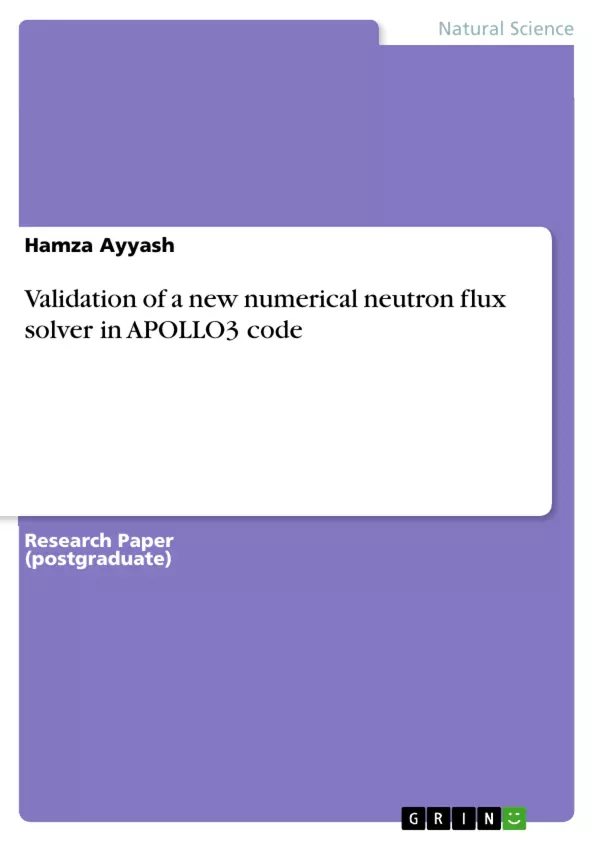The aim of this work is to test and compare the performance of three APOLLO3 flux solvers which are: MINOS IDT and NEMO against reference Monte Carlo and to test the new neutron transport equation solver NEMO. This testing is limited to numerical aspects by comparing the differences between: keff, flux and CPU time resulting of the three solvers. We will compare the value of keff against reference Monte Carlo. To do this we will expose these solvers to three benchmark problems: ZPR 1D, Stepanek, Takeda. In general the three solvers shows a very good agreements with Monte Carlo and sometimes with much less CPU time. Good results were founded by NEMO This work was performed at CEA, Saclay, DM2S/SERMA.
The APOLLO3 code is being developed by SERMA (Service d’Etudes de Réacteurs et de Mathématiques Appliquées du CEA). Its purpose is to provide a neutronic codes and studies for both thermal spectrum reactors and fast spectrum reactors. APOLLO3 code has four deterministic solvers MINOS, IDT, MINARET, TDT and recently a new solver called NEMO is introduced on an experimental basis. These different solvers have a common object that is to calculate the flux by solving the neutron transport equation, each of these solver uses different numerical methods for an angular variable and for a spatial variable
Frequently asked questions
What is the purpose of this document?
This document aims to test and compare the performance of three APOLLO3 flux solvers (MINOS, IDT, and NEMO) against reference Monte Carlo simulations and to evaluate the new neutron transport equation solver, NEMO. The focus is on numerical aspects, comparing keff, flux, and CPU time.
What solvers are being compared?
The document compares three APOLLO3 flux solvers: MINOS, IDT, and NEMO.
What benchmark problems are used for comparison?
The solvers are compared using three benchmark problems: ZPR 1D, Stepanek, and Takeda.
What is the ZPR 1D benchmark?
This is a one-dimensional plane geometry test case with six energy groups and heterogeneous material properties, simulating a fast-spectrum reactor.
What is the Stepanek benchmark?
This is a mono-kinetic test case with a two-dimensional Cartesian geometry.
What is the Takeda benchmark?
These are three-dimensional problems described in two energy groups for model 1 and four energy groups for models 2 and 3.
What methods do the solvers use?
- MINOS uses the SPn method for the angular variable and the finite element method RT (Raviart-Thomas) for space.
- IDT is based on the Sn method for the angular variable and offers three methods for the spatial variable: nodal method, characteristic method, and diamond differences method.
- NEMO is based on the Pn method for the angular variable and the Lagrange finite element method for the space variable.
What boundary conditions are supported by the solvers?
- MINOS supports zero flux and specular reflection boundary conditions.
- IDT supports specular reflection and vacuum boundary conditions.
- NEMO considers reflection and vacuum boundary conditions.
What is flux normalization, and how is it calculated in the benchmarks?
Scalar flux normalization ensures a consistent basis for comparison across solvers. The normalized flux for each group is determined by dividing the flux by its maximum value.
How is the error in keff calculated?
The error in keff is calculated as the absolute difference between the reference keff value (typically from IDT S8) and the keff value obtained from another solver, divided by the reference keff value.
What convergence criteria are used for outer iterations?
The solvers use a maximum of 500 outer iterations with convergence criteria of 10^-5 for keff and 10^-4 for pointwise fission source.
What are the computing conditions used in the simulations?
The calculations were performed on a Linux-based system with a 2.66 GHz Intel Xeon CPU and 4 GB of memory.
What is the goal of future development regarding solvers?
The document indicates that the goal is to improve the accuracy of calculations by using new finite elements, by adding the ability to perform calculation with the adaptive mesh, to use parallel computing and by optmizing the code.
- Quote paper
- Hamza Ayyash (Author), 2011, Validation of a new numerical neutron flux solver in APOLLO3 code, Munich, GRIN Verlag, https://www.hausarbeiten.de/document/370187


